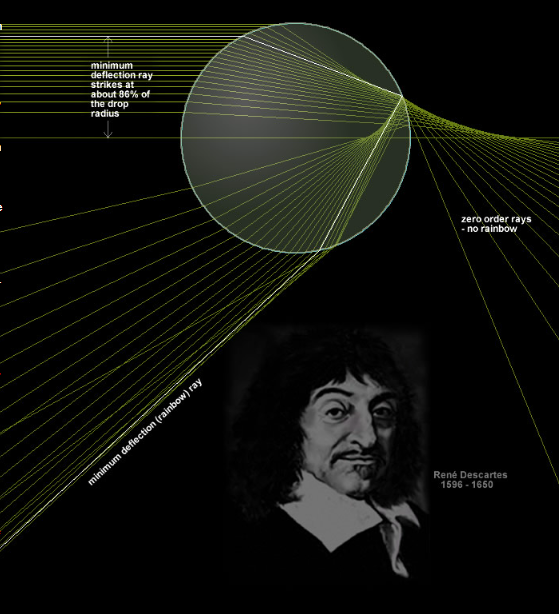Norway Rainbow & René Descartes
Norway Rainbow & René Descartes: A Closer Look at the Phenomenon
Rainbows are one of nature's most enchanting optical phenomena, captivating observers with their vibrant colors and ethereal beauty. While they have been observed and admired for centuries, it was the French philosopher and mathematician René Descartes who provided a groundbreaking explanation for the formation of rainbows in his seminal work, 'Discourse on the Method of Rightly Conducting the Reason, and Searching for Truth in the Sciences', published in 1637. Descartes' quantitative analysis of rainbows marked a significant milestone in the development of mathematical physics.
Understanding the Formation of Rainbows
The primary rainbow is formed by rays of light that are reflected once inside raindrops. When a ray of light enters a raindrop, its path is deflected based on where it strikes the drop. This deflection angle determines the position and characteristics of the rainbow. Descartes' ray diagram illustrates the paths of various rays and provides valuable insights into their behavior within raindrops.
The Impact of Ray Distance from the Center
The extent of deflection experienced by a ray depends on its distance from the center of the raindrop, also known as the impact parameter. Rays that pass closest to the drop's center are sharply reflected backward and emerge significantly deflected. As the distance from the center increases, the deflection becomes less pronounced. At approximately 86% of the radius, a minimum deflection angle is reached. This particular ray, depicted as white in the diagram, corresponds to the outer rim of the rainbow. Rays with larger impact parameters exhibit increased deflection.
The Rainbow Rim and Caustics
The minimum deflection ray, which corresponds to the rainbow rim, plays a crucial role in shaping the appearance of the rainbow. Multiple rays cluster at similar deflection angles, resulting in a bright and distinct rim. According to classical ray theory, the intensity of light at the minimum deflection angle is theoretically infinite. This phenomenon, known as a 'caustic,' is responsible for the luminosity observed at the rainbow rim.
Exploring the Rainbow Caustic
Rays that are deflected through greater angles fill the inside of the rainbow caustic with light, contributing to the vivid colors and radiant glow of the rainbow. As different wavelengths of light are refracted to varying degrees, the rainbow exhibits a distinct color sequence. Red light, for example, is refracted less than blue light and therefore experiences a smaller minimum deviation angle. Consequently, the red caustic is positioned on the outside of the primary bow.
Zero Order Rays and Their Role
While most sunlight passes through raindrops and emerges as first-order rays, a significant portion of the light, more than 90%, exits through the front of the drop. These "zero-order" rays do not undergo a minimum deviation and therefore do not contribute to the formation of a rainbow. Instead, they create a bright glow around the sun, obscuring our view of rainbows resulting from multiple reflections inside raindrops.
In conclusion, René Descartes' groundbreaking work on the formation of rainbows laid the foundation for our understanding of this captivating atmospheric phenomenon. By analyzing the behavior of light rays within raindrops, Descartes provided a quantitative explanation for the formation of rainbows, offering valuable insights into their intricate structure. The interplay between deflection angles, caustics, and wavelength-dependent refraction contributes to the mesmerizing beauty that graces our skies during rainfall. Next time you witness a rainbow stretching across the horizon, take a moment to appreciate the scientific wonders that underpin its enchanting display.

Rainbows over Troms�ysund, Norway imaged by Per Ivar Somby (more images). ©Per Ivar Somby, shown with permission.
The primary rainbow is formed by rays reflected once inside raindrops. How much a ray is deflected depends on where it strikes the drop. The ray diagram shows paths for a variety of rays. It is of the type first computed by Ren� Descartes and published in 1637 in his 'Discourse on the Method of Rightly Conducting the Reason, and Searching for Truth in the Sciences'. His description was the first quantitative explanation of the rainbow and one of the first uses of the methods later to be known as mathematical physics.
Rays passing on a line closest to the drop centre are sharply reflected backwards and emerge considerably deflected. As the ray distance from the centre (called the impact parameter) increases its deflection gets less. At about 86% of the radius a minimum deflection is reached. This ray is shown coloured white. At larger impact parameters the deflection increases again.
The minimum deflection ray corresponds to the rainbow rim. Many rays cluster at similar deflections and this makes the rainbow rim bright. In fact, classical ray theory predicts an infinite light intensity at the minimum deflection angle. This is a characteristic of 'caustics' and the rainbow is an example of one.
Rays deflected through greater angles fill the inside of the rainbow caustic with light.
The diagram is for a single colour. Red light is refracted less than blue and its minimum deviation angle is less. The red caustic is therefore on the outside of the primary bow.
Rays leave out of the front of the drop. More than 90% of sunlight does so. These 'zero order' rays have no minimum deviation. There is no caustic and no rainbow. Instead they make a bright glow around the sun and help prevent us seeing bows from three and four reflections inside raindrops.

Note: this article has been automatically converted from the old site and may not appear as intended. You can find the original article here.
Reference Atmospheric Optics
If you use any of the definitions, information, or data presented on Atmospheric Optics, please copy the link or reference below to properly credit us as the reference source. Thank you!
-
<a href="https://atoptics.co.uk/blog/norway-rainbow-ren-descartes/">Norway Rainbow & René Descartes</a>
-
"Norway Rainbow & René Descartes". Atmospheric Optics. Accessed on November 26, 2024. https://atoptics.co.uk/blog/norway-rainbow-ren-descartes/.
-
"Norway Rainbow & René Descartes". Atmospheric Optics, https://atoptics.co.uk/blog/norway-rainbow-ren-descartes/. Accessed 26 November, 2024
-
Norway Rainbow & René Descartes. Atmospheric Optics. Retrieved from https://atoptics.co.uk/blog/norway-rainbow-ren-descartes/.